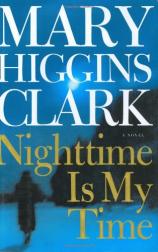Nighttime Is My Time
Review
Nighttime Is My Time
Mary Higgins Clark is as talented as she is prolific. Her body of work is comprised of twenty-nine books in her own name and three written with her daughter. Almost all of them rise quickly to the bestseller list. The latest addition to her mounting number of titles is NIGHTTIME IS MY TIME. In her unique style she tells the story of a group of people, originally from a small town in upstate New York, who gather together at their private high school to celebrate their twentieth reunion. Each of the attendees is there with a hidden agenda that goes beyond reuniting with old buddies, and each one of them harbors a deep hatred for the others.
Jack Emerson is the man who stayed in town and became a real estate mogul with an ego as big as his appetite. He has planned this event around an awards ceremony for the six most successful alumni from that graduating class. The weekend and recognition dinner are really fundraising ploys that will help get a new addition to the school and hopefully attract new students.
Carter Stewart had been "a scrawny, untidy child of a scrawny, untidy mother … [who often forgot to do the laundry. Stewart took the task upon himself and … had more often than not] gone to school slightly soiled or freakish looking." This made him the brunt of cruel jokes and malicious laughter. "He'd started writing in college, off-beat one-act plays … and that led to a postgraduate stint at Yale. That was when he dropped his first name, Howard --- or Howie, as he'd been called at Stonecraft. He had his first Broadway hit before he was thirty. He was reputed to be a loner [with houses all over the country.] Withdrawn, unpleasant, perfectionist, genius --- those were some of the words used to describe him in articles." Carter is an embittered man who writes dark plays in the spirit of Edward Albee. His disdain and resentment toward his old schoolmates is palpably hostile.
Jean Sheridan was a scholarship student at Stonecroft High School; her parents were the joke of the town because of their public displays of marital discord and fighting. The impact of their behavior made Jean a quiet, sad and introverted girl. Today she is a respected historian, a professor at Georgetown University, and a bestselling author whose successful film adaptation of her biography of Jane Adams is listed among her credits. She travels from Washington back to her hometown with the knowledge that her memories will surface and she will have to cope with them. But she is more concerned about several communications she has received from an anonymous person who knows her deepest and most painful secret. The tone of the faxes and notes is clearly threatening, not to expose the secret but to do great harm in other ways.
Mark Fleischman is a successful Boston psychiatrist who treats troubled adolescents and had a "call-in television program that had recently become syndicated." His personal reason for attending the dreaded award weekend is that he wanted to have a chance "to figure out the difference between his perception of himself as it had been when he was growing up [in Cornwall] and the reality, as he understood it, of who he was now. Am I hoping to exorcise my own demons? He wondered."
Robby Brent is a well-known and very successful comedian who has been compared to Don Rickles. He delivers a rapier kind of wit that cuts to the marrow of anyone he targets in his performances. "I either disliked or hated just about all of my classmates, he thought. Then why did I accept the invitation to come here? I'll get plenty of new material for the act, he promised himself. There was another reason of course, but he pushed it out of his mind. I won't go there … at least not now."
Laura Wilcox is the gorgeous golden girl who went to Hollywood to become an actress and caught the brass ring, at least for a few years. She had had a successful run on a long canceled television series and was desperate to re-launch her career. But for the moment, she's broke and desperate. She must make use of her "womanly wiles" to cement contacts or she'll end up on the street. " … She'd wear the Chanel tonight. Go for glitter. Knock them dead. Look successful, even if you are behind in your taxes and the IRS has a lien on the house." She always had the boys wrapped around her little finger and during this weekend she would tighten those strings.
The six honorees are wary of one another, and as the events unfold they find it harder and harder to hide their mutual animosities. As we move on to the supporting characters: the local cop who just never gives up trying to solve the murder of a teenager twenty years before, the grieving mother whose daughter was the murder victim, and Jake, a sixteen-year-old senior at Stonecroft who fashions himself as an investigative reporter and sees conspiracies around every corner. He is the typical bungler with talent, in his case, photography. He is tenacious and devoted to getting a scoop out of this weekend event. He manages to get in everyone's way, but he is the one to find the missing clue that leads to solving the teen's murder case. With this relatively large cast it's disappointing that most of the characters are stereotypes and one-dimensional.
Unfortunately, the story just doesn't work, nor does it hold together in any kind of cohesive progression. And with so many subplots and loose threads, readers have to fight their way through an avalanche of red herrings strung across almost every page. Mary Higgins Clark is so well-known for her suspenseful and high velocity plotting, one wonders what happened here. The hackneyed storyline has been done --- and no one did it better than Agatha Christie in THEN THERE WERE NONE/TEN LITTLE INDIANS. There's no question that Clark can write --- in fact she does it very well. The problem is that she has taken a cliché ridden mystery device and not spent enough time in the heads of the characters.
We don't really get a clear picture of the psychopath, and his reasons for becoming a serial killer are not believable. He uses the guise of an owl, which is where the title comes from. He repeats, "Nighttime is my time" as he gives in to his bloodthirstiness. In this story the owl image is one of death, one of a predatory nature, one of doom. But in cultures all over the world the owl is far more than a symbol of darkness or death and is a poor choice for the maniac to hide behind. Jean Sheridan, around whom the story swirls, is a wishy-washy woman despite her academic accomplishments and popularity.
Overall, NIGHTTIME IS MY TIME just doesn't live up to the expectations or the high standards Ms. Clark's fans have come to expect from her. We hope her next book will have the snap, crackle and pop of her previous thrillers.
Reviewed by Barbara Lipkien Gershenbaum on January 13, 2011





